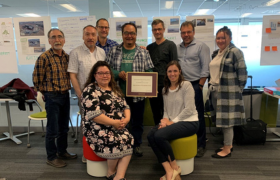Arn Keeling

Department Head, Department of Geography, Faculty of Humanities and Social Sciences
What are you currently working on? Can you tell us a bit about your current research focus?
Alongside my longstanding research focus on the historical and contemporary encounters of Indigenous communities with mineral development in Northern Canada, my recent work focuses on the often-neglected challenge of mine closure and reclamation.
Mineral development frequently generates extensive and complex environmental problems, including toxicity, acidification of local waterways, massive waste dumps, and degraded ecologies. These enduring impacts may disrupt Indigenous land uses such as hunting and trapping, as well as threatening environmental and human health for long periods post-mining. Around the Arctic, governments and local communities face the daunting challenge of cleaning up and managing mining’s environmental legacies at thousands of post-mining sites. They must also plan for the inevitable closure of currently operational and projected mines.
These challenges are complicated by the uncertainties of Arctic environmental change, which presents shifting baselines for reclamation as well as complex technical challenges related to managing waste, toxicity, and engineered facilities long into the future.
When and why did you first feel inspired to work in this area?
This research focus grew out of concerns expressed by Northern research partners about issues of mine closure and reclamation, both at abandoned sites and at active, yet-to-close mines.
At the same time, I joined two interdisciplinary networks of researchers, one Nordic and one Canadian, examining the science, policy, and practices around mine reclamation. These initiatives have led to ongoing work focusing on the social aspects of mine closure, including the engagement of local and Indigenous communities in planning for post-mining transitions while ensuring positive environmental outcomes.
Can you share a memory with us of an interesting day in your recent work and research life?
One of the great rewards of this project is working alongside Inuit community and government representatives, fellow researchers and students, and mining company officials on a unique collaborative mine closure planning initiative with Raglan Mine in Nunavik, Quebec.
This work entails long-term dialogue and co-learning around both the technical requirements and the social aspects of planning for closure--well in advance of the forecast end of mining. To do this, over the last 5 years we have toured closed mine sites, visited the operating mine facilities, held Inuktitut terminology workshops, learned about mine reclamation practices, and applied our collective knowledge to the review of the mine's closure plan.
The relationships built around these activities have been very important to the success of the process.
What makes Memorial particularly suited for your work?
Memorial is an ideal location for this work, based on the university's commitment to publicly engaged research and its focus on Arctic environments and communities. By supporting and recognizing public engagement and collaboration (including in the collective agreement), Memorial allows researchers to prioritize long-term partnerships over 'helicopter' and extractive research processes.
In fact, the research contributions of collaborators on the mine closure committee was recognized by the 2022 HSS Dean's Research Partner Award. The committee also enjoyed visiting St. John's for one of its meetings, too!
What is something you’d like for people to know about the ocean or the north (or your more specific focus area)?
Mineral development and resource extraction are often associated with Arctic and northern regions.
In the era of land claims and Indigenous sovereignty, it is essential that Indigenous knowledge, rights, and land-based activities are respected and protected. Mines are much more than a hole in the ground: even remote mines are complex, interconnected facilities whose activities affect Northern lands and waters (including oceans).
With the growing demand for critical minerals for the green transition, these activities much engage directly with communities and rights holders to ensure that the negative legacies of past developments are not repeated.